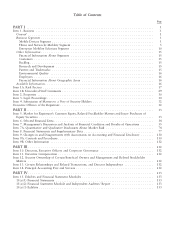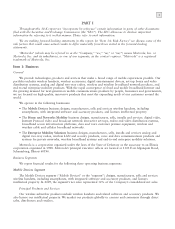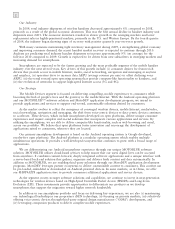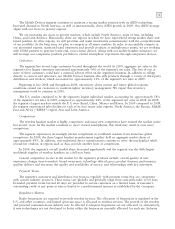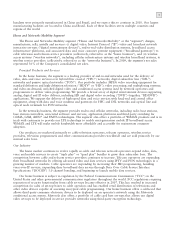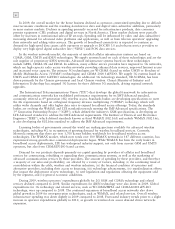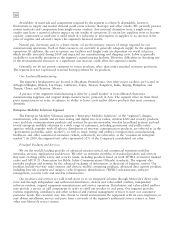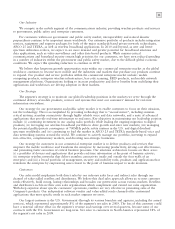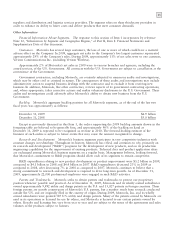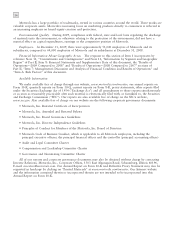Motorola 2009 Annual Report Download - page 18
Download and view the complete annual report
Please find page 18 of the 2009 Motorola annual report below. You can navigate through the pages in the report by either clicking on the pages listed below, or by using the keyword search tool below to find specific information within the annual report.
10
Availability of materials and components required by the segment is relatively dependable, however,
fluctuations in supply and market demand could cause selective shortages and affect results. We currently procure
certain materials and components from single-source vendors. Any material disruption from a single-source
vendor may have a material adverse impact on our results of operations. If certain key suppliers were to become
capacity constrained or insolvent it could result in a reduction or interruption in supplies or an increase in the
price of supplies and adversely impact the segment’s financial results.
Natural gas, electricity, and, to a lesser extent, oil are the primary sources of energy required for our
manufacturing operations. Each of these resources are currently in generally adequate supply for the segment’s
operations. In addition, the cost to operate our facilities and freight costs are dependent on world oil prices,
which steadily increased during 2009 and impacted our manufacturing and shipping costs. Labor is generally
available in reasonable proximity to the segment’s manufacturing facilities. However, difficulties in obtaining any
of the aforementioned resources or a significant cost increase could affect the segment’s results.
Generally, we do not permit customers to return products, other than under standard warranty provisions.
The segment has not experienced seasonal buying patterns for its products.
Our Facilities/Manufacturing
The segment’s headquarters are located in Horsham, Pennsylvania. Our other major facilities are located in:
Arlington Heights, Illinois; San Diego, California; Taipei, Taiwan; Bangalore, India; Beijing, Hangzhou and
Tianjin, China; and Reynosa, Mexico.
A portion of the segment’s manufacturing is done by a small number of non-affiliated electronics
manufacturing suppliers and original design manufacturers, primarily in Asia. The segment relies on these third-
party manufacturers in order to enhance its ability to lower costs and/or deliver products that meet consumer
demands.
Enterprise Mobility Solutions Segment
The Enterprise Mobility Solutions segment (‘‘Enterprise Mobility Solutions’’ or the ‘‘segment’’) designs,
manufactures, sells, installs and services analog and digital two-way radios, wireless LAN and security products,
voice and data communications products and systems for private networks, wireless broadband systems and end-
to-end enterprise mobility solutions to a wide range of customers, including government and public safety
agencies (which, together with all sales to distributors of two-way communication products, are referred to as the
‘‘government and public safety market’’), as well as retail, energy and utilities, transportation, manufacturing,
healthcare and other commercial customers (which, collectively, are referred to as the ‘‘commercial enterprise
market’’). In 2009, the segment’s net sales represented 32% of the Company’s consolidated net sales.
Principal Products and Services
We are the world’s leading provider of advanced mission-critical and commercial enterprise mobility
networks, services, applications and devices. We offer an extensive portfolio of standard products and services
that meet evolving public safety and security needs, including products based on both TETRA (terrestrial trunked
radio) and APCO 25 (Association for Public Safety Communications Officials) standards. The segment also
provides products and systems for the advanced exchange of information at the point of business activity. Our
products include two-way radio systems and devices, mobile computing products, advanced data capture products
including barcode scanners and imagers, radio frequency identification (‘‘RFID’’) infrastructure, software
management, security tools and wireless infrastructure.
Our products and services are sold stand-alone or as an integrated solution through Motorola’s direct sales
force and through independent and authorized distributors, dealers and value-added resellers, independent
software vendors, original equipment manufacturers and service operators. Distributors and value-added resellers
may provide a service or add components in order to resell our product to end users. Our segment provides
systems engineering, installation and other technical and systems management services to meet our customers’
particular needs. The customer may also choose to install and maintain the equipment with its own employees, or
may obtain installation, service and parts from a network of the segment’s authorized service centers or from
other non-Motorola service centers.


